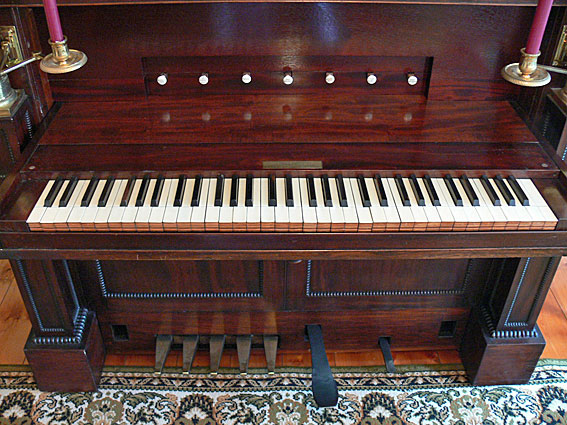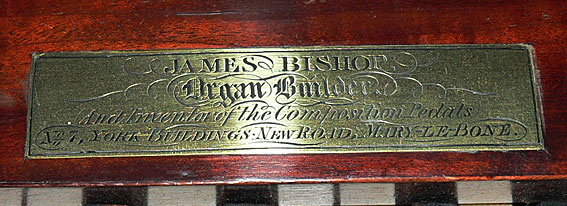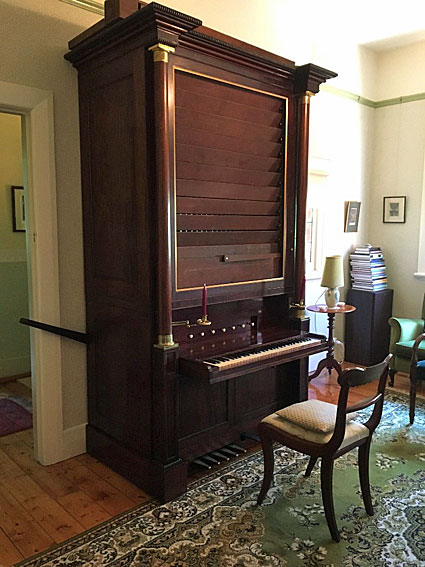
James Bishop chamber organ, Camberwell, Victoria
(photograph by John Maidment [August 2018])

James Bishop chamber organ, Camberwell, Victoria
(photograph by John Maidment [August 2018])
Historical and Technical Documentation by John Maidment
© OHTA, 2016 (last updated August 2018)
The home in which these objects are housed was architect-designed and completed just before the onset of the first world war, c.1913. Built in the Federation arts and crafts style, it incorporates leadlight windows with Glasgow rose motifs derived from Charles Rennie Mackintosh, terra cotta roofing tiles from Pierre Sacoman, Marseilles, France and bricks from the Fritsch Holzer brickworks in East Hawthorn.
The chamber organ was built in 1828 by James Bishop, no 7, York Buildings, New Road, Mary-le-Bone, London as shown on the brass nameplate. It was commissioned by Philip Wynter, the President of St John's College, Oxford and was installed in his private rooms there.1 Wynter was for a time Vice-Chancellor of the University of Oxford. The date is substantiated by a pencil inscription on the pallet rail "C. Petrie 1828" – Petrie was an employee of Bishop, and the organ is on a published list of Bishop organs cited by Nicholas Thistlethwaite.2 This was the year Bishop moved to larger premises in Lisson Grove so he could construct the organ for St James's Church, Bermondsey.

James Bishop chamber organ, Camberwell, Victoria – keyboard and drawstops
(photograph by John Maidment [October 2016])

James Bishop chamber organ, Camberwell, Victoria – paper label
(photograph by Fokke Feenstra [August 2014])
The organ incorporates several features invented by Bishop, such as the five composition pedals, a concussion bellows mounted horizontally under the windchest and the small-scaled treble wooden Claribella, of which this is among the earliest surviving examples. The casework, made from superbly figured mahogany and designed in the Grecian style, incorporates carved mouldings, a prominent cornice, two turned columns at the front and splendid brass capitals and bases to the columns, and original brass candle sconces. The casework is likely to have been outsourced to cabinet maker George T. Tooke, of 23 Judd Street, Brunswick Square.3 A visually identical instrument made in 1835 by Bishop survives at Holy Trinity Church, Cressy, Tasmania which was built for the Archer family and placed at their home 'Panshanger', near Longford. Another Bishop chamber organ from the 1840s survives at St Andrew's Church, Carrick, Tasmania.
The specification is as follows:
| OPEN DIAPASON BASS ) OPEN DIAPASON STOPT DIAPASON CLARIBELLA DULCIANA BASS DULCIANA TREBLE PRINCIPAL |
[8] [8] [8] [8] [8] [8] [4] |
metal from TG, GG-F# 1-12 repeats 13-25, 12 pipes, bottom 5 pipes planted at rear*, bass from Stopt Diapason (12 notes) metal TG up, 42 pipes wood, pierced stoppers in treble, 66 pipes, bottom pipes mitred middle C up wood, 37 pipes wood & metal to TB, 12 pipes, bass from Stopt Diapason metal middle C up, 37 pipes metal from G, 54 pipes |
Compass: GG-c4, 66 notes
Pipework entirely enclosed in swell box (apart from GG pipe), with non-hitchdown lever pedal
5 composition pedals
Foot blowing with three positions for the lever and a hand lever
Wind indicator
Wind pressure: 52 mm (2 inches)
Pitch: A = 422
Total: 260 pipes
*adds bass of Stopt Diapason to Open Diapason Bass4
Following Wynter's death in 1871, the location of the organ cannot be traced until the 1980s. At some stage, a wooden cover was made to fit over the keyboard which, when folded back, incorporated a music desk. A façade of 19 incongruous wooden gilt dummy pipes was also fitted, placed on an inverted v-shaped toeboard.5 Both these features, which were non-original, have been removed at various stages. It also appears that the organ originally had no pipe or action for the bottom GG# and this was later fitted, resulting in the mitred GG# pipe being conveyed off to the top of the organ via a metal conveyance tube, but has been placed in storage. The keyboard was modified to insert a GG# key, this being evident in score marks cut into the ivory surfaces. A hand blowing lever was also subsequently fitted to the rear of the left-hand side of the case.
An inscription in pencil on the pallet rail reads:
"Martin Renshaw, of North Lymington, Folkestone, restored the organ October 1985 – February 1986 for V. Proctor, Ludlow. It had come from Christ Church, Blacklands, Hastings, formerly the property of Edward Nye."6
Nye was a former Mayor of Hastings, UK. Vivian Proctor lived at Orleton, outside Ludlow.
Martin Renshaw added pedals to the organ and an independent pedal pipes together with an electric blower which was attached to the underside of one of the bellows feeders. This was accommodated by placing the organ on a plinth.7 By the time the organ was acquired by Netherlands organbuilder F.R. Feenstra, from a Dutch Reformed Church pastor, all these additions had been discarded.
The instrument is ingenious in its construction. The keyboard is hinged and folds vertically into the case front to conserve space. The five composition pedals operate horizontal wooden fans at the rear of the instrument which engage the stop action – this operates from horizontal iron rollers in the middle of the windchest to economise width. The small ivory drawstops have exquisite engraving in upper case lettering with ruled lines. The longest wooden pipes are mitred at right angles with the longest metal pipes, up to six feet in length, placed at a lower level at the rear of the organ. The wind feeder operates from three positions at the front of the organ, together with a wooden lever on the left hand side of the case. The reservoir has cast iron weights with the impressed mark "IB" - Iacobus Bishop. The swell shutters open upwards, a feature later used by Henry Willis, and to keep them open, the iron pedal has to be depressed; there is no hitch-down mechanism. The shutter front has a faint inscription "IC" – it is just possible that this may have been made by John Courcelle senior, who had been employed by the Bishop firm [I = Iohannes]. The organ is still foot or hand blown.
Some of the metal pipework has note inscriptions in Indian ink and is of high percentage lead. It has been fitted with tuning slides, possibly in the 1980s. The wooden pipework includes a Stopt Diapason down to GG, with pierced stoppers in the treble, and a Claribella, a treble stop of extraordinarily small scale. The organ is now tuned to 1/5 comma meantone, which is very close to Bishop's own temperament, which survived on the Bermondsey organ and the pitch is lower than current standard.
The whole organ is mounted on a base board fitted with iron rollers so the organ can be moved forward for tuning and maintenance.
Restoration work has been undertaken by F.R. Feenstra Orgelbouw, Grootengast, The Netherlands in 2015-2016, and has included the following:
The upper front panel has been fitted with stretched crimson silk by Hargraves Pipe Organs Pty Ltd and a mahogany and cedar music desk has been reconstructed by the same firm, using elements of the original including the horizontal shelf and gilt music clips, its design based upon contemporary Bishop instruments at 'The Argory', Northern Ireland and at Carrick and Cressy in Tasmania.

James Bishop chamber organ, Camberwell, Victoria: reconstructed music desk
(photograph by John Maidment [August 2018])
The organ was air-freighted from The Netherlands and installed in its present location in early October 2016 with the assistance of Campbell Hargraves of Hargraves Pipe Organs Pty Ltd.
The writer of J.C. Bishop's obituary said:
Mr. Bishop early gained a special celebrity for the manufacture of a class of small organ designed for chamber use, and in these he has never been excelled. They had but one clavier and rarely contained more than seven or eight stops, yet in grace, purity and a certain unctuous richness of tone, they were altogether unrivalled.8
The sound of the instrument is exquisite, with a quality rarely to be found.

James Bishop chamber organ, Camberwell, Victoria: Claribella pipes
(photograph by John Maidment [October 2016])

James Bishop chamber organ, Camberwell, Victoria: inscription on Principal pipes
(photograph by John Maidment [October 2016])

James Bishop chamber organ, Camberwell, Victoria: composition pedals, foot blowing and swell lever
(photograph by John Maidment [October 2016])

James Bishop chamber organ, Camberwell, Victoria: Bishop nameplate
(photograph by John Maidment [October 2016])

James Bishop chamber organ, Camberwell, Victoria: composition pedal action at rear of organ
(photograph by Fokke Feenstra [April 2016])

James Bishop chamber organ, Camberwell, Victoria: swell front
(photographs by John Maidment [October 2016])

Anonymous barrel organ, Camberwell, Victoria
(photograph by John Maidment [February 2011])
The second instrument is an English barrel organ, again in a splendid mahogany case, which may be dated at around 1800. It was purchased in Geelong, Victoria in 2006 but had come from Carlisle, UK around 2005. The maker is unknown, but the shield in the front filled with 15 gilt dummy pipes resembles other barrel organs built by James Davis. The casework is of richly figured mahogany with boxwood stringing and of the best 'London' quality. It had four ranks of pipework (stopped wood 8, metal 4, 2⅔, 2) operating from 16 notes.
The oak slider chest and rackboard, cranking mechanism, bellows and tune list survive, but regrettably only one metal pipe survives out of the original 64. There were originally four barrels each of 10 tunes and the handwritten tune list survives on the inside of the side door in the case. The barrels too have been discarded. The base of the instrument forms a cabinet for the barrels. The dummy façade pipes were regilded by Marc Nobel and the surrounding panel restored. The pipes are backed with green silk, along the lines of the original, of which fragments were found.

Anonymous barrel organ, Camberwell, Victoria - windchest and pipe rack
(photograph by John Maidment [February 2011])

Anonymous barrel organ, Camberwell, Victoria - tune list inside case door
(photograph by John Maidment [February 2011])

Anonymous barrel organ, Camberwell, Victoria – feeders and reservoir
(photograph by John Maidment [February 2011])
1 Affixed to the inside left panel, stating "The Revd The President of St John's College, Oxford, 11 packages"
2 Nicholas Thistlethwaite, 'The Early Career of J.C. Bishop, Organ-Builder, 1807-29', BIOS Journal, vol 25, p.28
3 Laurence Elvin, Bishop and Son Organ Builders, p.46
4 Specification noted by John Maidment October 2016
5 Personal communication from Martin Renshaw to John Maidment July 2016
6 Noted at the Feenstra workshop by John Maidment July 2015
7 Personal communication from Martin Renshaw to John Maidment May 2016
8 The Musical World, 23 December 1854, pp 836-37